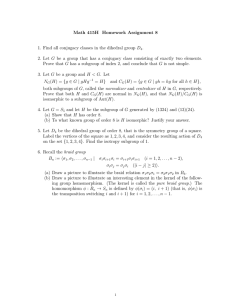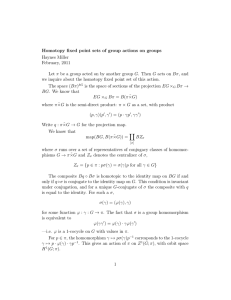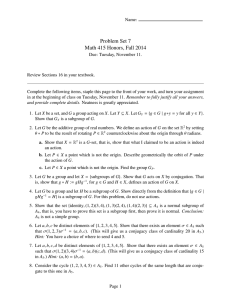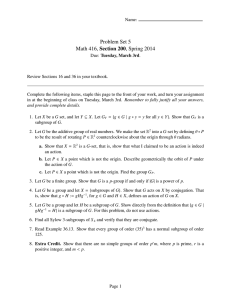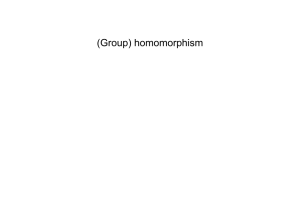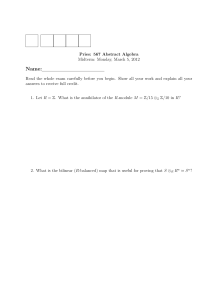8. Homomorphisms and kernels
advertisement
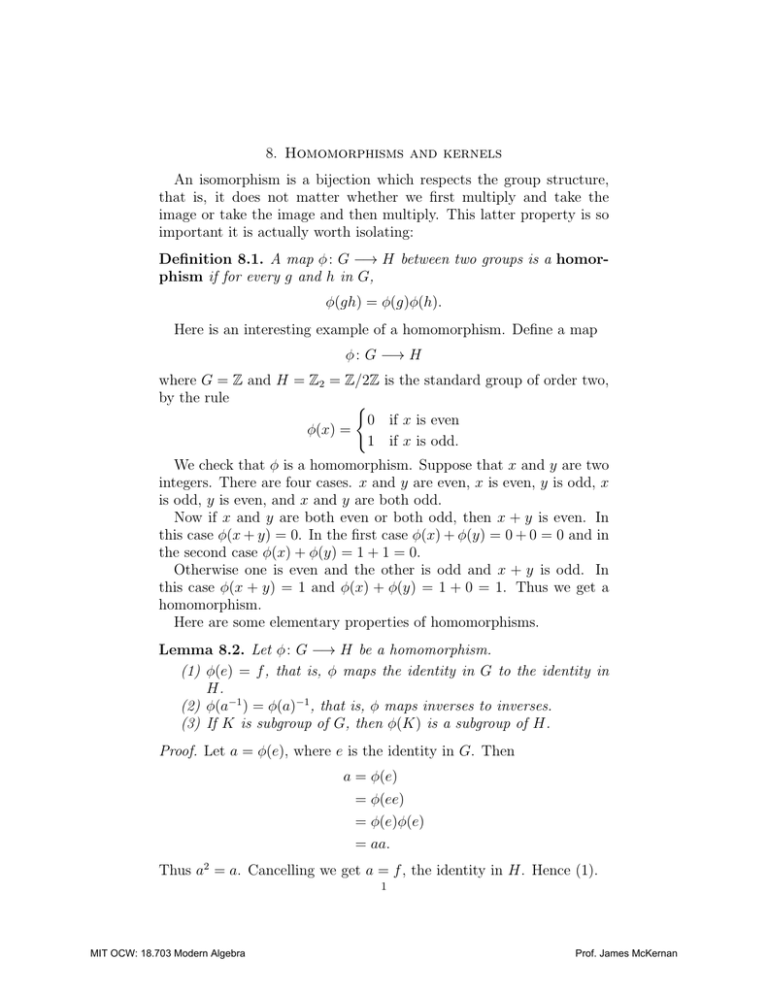
8. Homomorphisms and kernels
An isomorphism is a bijection which respects the group structure,
that is, it does not matter whether we first multiply and take the
image or take the image and then multiply. This latter property is so
important it is actually worth isolating:
Definition 8.1. A map φ : G −→ H between two groups is a homor­
phism if for every g and h in G,
φ(gh) = φ(g)φ(h).
Here is an interesting example of a homomorphism. Define a map
φ : G −→ H
where G = Z and H = Z2 = Z/2Z is the standard group of order two,
by the rule
0 if x is even
φ(x) =
1 if x is odd.
We check that φ is a homomorphism. Suppose that x and y are two
integers. There are four cases. x and y are even, x is even, y is odd, x
is odd, y is even, and x and y are both odd.
Now if x and y are both even or both odd, then x + y is even. In
this case φ(x + y) = 0. In the first case φ(x) + φ(y) = 0 + 0 = 0 and in
the second case φ(x) + φ(y) = 1 + 1 = 0.
Otherwise one is even and the other is odd and x + y is odd. In
this case φ(x + y) = 1 and φ(x) + φ(y) = 1 + 0 = 1. Thus we get a
homomorphism.
Here are some elementary properties of homomorphisms.
Lemma 8.2. Let φ : G −→ H be a homomorphism.
(1) φ(e) = f , that is, φ maps the identity in G to the identity in
H.
(2) φ(a−1 ) = φ(a)−1 , that is, φ maps inverses to inverses.
(3) If K is subgroup of G, then φ(K) is a subgroup of H.
Proof. Let a = φ(e), where e is the identity in G. Then
a = φ(e)
= φ(ee)
= φ(e)φ(e)
= aa.
Thus a2 = a. Cancelling we get a = f , the identity in H. Hence (1).
1
MIT OCW: 18.703 Modern Algebra
Prof. James McKernan
Let b = a−1 .
f = φ(e)
= φ(ab)
= φ(a)φ(b),
and
f = φ(e)
= φ(ba)
= φ(b)φ(a).
But then φ(b) is the inverse of φ(a), so that φ(a−1 ) = φ(a)−1 . Hence
(2).
Let X = φ(K). It suffices to check that X is non-empty and closed
under products and inverses. X contains f the identity of H, by (1).
X is closed under inverses by (2) and closed under products, almost by
definition. Thus X is a subgroup.
D
Instead of looking at the image, it turns out to be much more inter­
esting to look at the inverse image of the identity.
Definition-Lemma 8.3. Let φ : G −→ H be a group homomorphism.
The kernel of φ, denoted Ker φ, is the inverse image of the identity.
Then Ker φ is a subgroup of G.
Proof. We have to show that the kernel is non-empty and closed under
products and inverses.
Note that φ(e) = f by (8.2). Thus Ker φ is certainly non-empty.
Now suppose that a and b are in the kernel, so that φ(a) = φ(b) = f .
φ(ab) = φ(a)φ(b)
= ff
= f.
Thus ab ∈ Ker φ and so the kernel is closed under products. Finally
suppose that φ(a) = e. Then φ(a−1 ) = φ(a)−1 = f , where we used
(8.2). Thus the kernel is closed under inverses, and the kernel is a
subgroup.
D
Here are some basic results about the kernel.
Lemma 8.4. Let φ : G −→ H be a homomorphism.
Then f is injective iff Ker φ = {e}.
2
MIT OCW: 18.703 Modern Algebra
Prof. James McKernan
Proof. If f is injective, then at most one element can be sent to the
identity f ∈ H. Since φ(e) = f , it follows that Ker φ = {e}.
Now suppose that Ker φ = {e} and suppose that φ(x) = φ(y). Let
g = x−1 y. Then
φ(g) = φ(x−1 y)
= φ(x)−1 φ(y)
= f.
Thus g is in the kernel of φ and so g = e. But then x−1 y = e and so
x = y. But then φ is injective.
D
It turns out that the kernel of a homomorphism enjoys a much more
important property than just being a subgroup.
Definition 8.5. Let G be a group and let H be a subgroup of G.
We say that H is normal in G and write H < G, if for every g ∈ G,
gHg −1 ⊂ H.
Lemma 8.6. Let φ : G −→ H be a homomorphism.
Then the kernel of φ is a normal subgroup of G.
Proof. We have already seen that the kernel is a subgroup. Suppose
that g ∈ G. We want to prove that
g Ker φg −1 ⊂ Ker φ.
Suppose that h ∈ Ker φ. We need to prove that ghg −1 ∈ Ker φ.
Now
φ(ghg −1 ) = φ(g)φ(h)φg −1
= φ(g)f φ(g)−1
= φ(g)φ(g)−1 = f.
Thus ghg −1 ∈ Ker φ.
D
It is interesting to look at some examples of subgroups, to see which
are normal and which are not.
Lemma 8.7. Let G be an abelian group and let H be any subgroup.
Then H is normal in G.
Proof. Clear, as for every h ∈ H and g ∈ G,
ghg −1 = h ∈ H.
D
3
MIT OCW: 18.703 Modern Algebra
Prof. James McKernan
So let us look at the first interesting example of a group which is not
abelian.
Take G = D3 . Let us first look at H = {I, R, R2 }. Then H is normal
in G. In fact, pick g ∈ D3 . If g belongs to H, there is nothing to prove.
Otherwise g is a flip. Let us suppose that it is F1 . Now pick h ∈ H
and consider ghg −1 . If h = I then it is clear that ghg −1 = I ∈ H.
So suppose that h = R. Then
ghg −1 = F1 RF1
= R2 ∈ H.
Similarly, if h = R2 , then ghg −1 = R ∈ H.
Thus H is normal in G.
Now suppose that H = {I, F1 }. Take h = F1 and g = R. Then
ghg −1 = RF1 R2
= F2 .
So gHg −1 = H.
Lemma 8.8. Let H be a subgroup of a group G.
TFAE
(1) H is normal in G.
(2) For every g ∈ G, gHg −1 = H.
(3) Ha = aH, for every a ∈ G.
(4) The set of left cosets is equal to the set of right cosets.
(5) H is a union of conjugacy classes.
Proof. Suppose that (1) holds. Suppose that g ∈ G. Then
gHg −1 ⊂ H.
Now replace g with g−1, then
g −1 Hg ⊂ H,
so that multiplying on the left by g −1 and the right by g
H ⊂ gHg −1 .
But then (2) holds.
If (2) holds, then (3) holds, simply by multiplying the equality
aHa−1 = H,
on the right by a.
If (3) holds, then (4) certainly holds.
Suppose that (4) holds. Let g ∈ G. Then g ∈ gH and g ∈ Hg. If
the set of left cosets is equal to the set of right cosets, then this means
4
MIT OCW: 18.703 Modern Algebra
Prof. James McKernan
gH = Hg. Now take this equality and multiply it on the right by g −1 .
Then certainly gHg −1 ⊂ H, so that H is normal in G. Hence (1).
Thus (1), (2), (3) and (4) are all equivalent.
Suppose that (5) holds. Then H = ∪Ai , where Ai are conjugacy
classes. Then
gHg −1 = ∪gAi g −1
= ∪Ai
= H.
Thus H is normal.
Finally suppose that (2) holds. Suppose that a ∈ H and that A is
the conjugacy class to which a belongs. Pick b ∈ A. Then there is an
element g ∈ G such that gag −1 = b. Then b ∈ gHg −1 = H. So A ⊂ H.
But then H is a union of conjugacy classes.
D
Using this the example above becomes much easier with S3 . In the
first case we are looking at H = {e, (1, 2, 3), (1, 3, 2)}. In this case H is
in fact a union of conjugacy classes. (Recall that the conjugacy classes
of Sn are entirely determined by the cycle type). So H is obviously
normal. Now take H = {e, (1, 2)}, and let g = (2, 3). Then
gHg −1 = {geg −1 , g(1, 2)g −1 }
= {e, (1, 3)}.
Thus H is not normal in this case.
Given this, we can give one more interesting example of a normal
subgroup.
Let G = S4 . Then let H = {e, (1, 2)(3, 4), (1, 3)(2, 4), (1, 4)(2, 3)}.
We have already seen that H is a subgroup of G. On the other hand,
H is a union of conjugacy classes. Indeed the three non-trivial elements
of H represent the only permutations with cycle type (2, 2). Thus H
is normal in G.
5
MIT OCW: 18.703 Modern Algebra
Prof. James McKernan
MIT OpenCourseWare
http://ocw.mit.edu
18.703 Modern Algebra
Spring 2013
For information about citing these materials or our Terms of Use, visit: http://ocw.mit.edu/terms.
